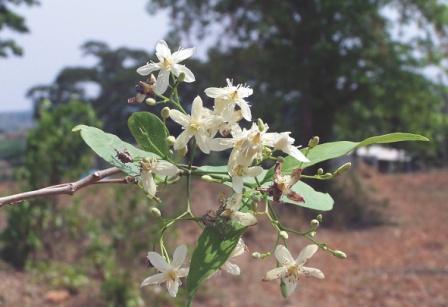
















Wrightia tinctoria is a small to medium-size deciduous tree, to 18 m tall and to 20 cm dbh with green marks on the stem and producing milky-whiteresin. The bark is smooth, somewhat corky and pale grey. Leaves large up to 10 cm long by 5 cm wide, simple, opposite, decussate and glabrous (sometimes puberulous beneath). Young leaves are bluish with reddish nerves. Flowers white, fragrant, 1-5 cm long, arranged in lax dichasial cymes (5 cm long).
Australia, India, Myanmar, Nepal, Vietnam
Natural Regeneration It is regenrated by seed. Artificial Regeneration It is regenerated by seed and stem cuttings. Seed collection Storage 1. The seed are collected after the fruit matures between November to January. 2. The seeds are collected at the stage of well matured. 3. The seeds may stored upto 6 months in gunny bags or others. 4. The seeds are either collected from the ground or from the tree. Pretreatment The seeds are treated with hot water for 3 hours or cold water for 6 hours to get better germination. Nursery Technique 1. Sowing of seeds in broadcast or line sowing in the well pulverizedsandy loam soil. 2. The seed is mixed with sand or ash ensure uniform sowing. 3. The seed is lightly covered with soil, the depth of sowing should be be more than required. Watering is done with light spray. 4. Altenately the seeds may be sown for 2-3 hours. 5. November -December is the favourable time for sowing. 6. The germination takes place within 10-15 days. 7. The germination percentage is 60.
1. The area should be ploughed at 30-45 cm depth. Planting is done at the spacing of 6*6 m is maintained. 2. Pits of 90 cm3 are opened during the summer and exposed to the sun. Pits filled with top soil with FYM and superphosphate and Potash. 3. At the time of planting seedlings are plante with the ball of earth. 4. The grafts are staked immediately after planting to protect from strong winds. 5. The polythenestrip are used for securing the graft joining should be removed a month after plabting The new sprouts emerging on th rootstock below the graft joint should be removed immediately. 6. The plants intercrop with banana, pineapple and tomato and cabbage etc.,
pest and diseease: In India, some moderate diseases caused by Sarcinella apocynacearum and Cercospora wrightia, which causes leafspot disease in the nursery is reported
Rotation :30 years
Timber: The timber is high in quality, valuable, small, and white. The white wood, which is very fine, is used for turnery, carving, toy making, matchboxes, small boxes and furniture. Medicine: The juice from fresh unripe fruits is used for coagulating milk. The seeds are said to be aphrodisiac and anthelminthic. The leaves are used to relieve toothache when chewed with salt. In Nepal, the milky juice is used to stop bleeding. Also the leaves and roots are pounded in water for treatment of fever. The seeds yield deep red, semi-drying oil, which has medicinal value. In Indian traditional medicine, the bark and leaves are used to treat psoriasis, stomach pains, toothache, and dysentery.
Dye: The leaves, flowers, fruits and roots is a sources of indigo-yielding glucoside, which produces a blue dye or indigolike dye. Fodder: The leaves are lopped for livestock fodder.